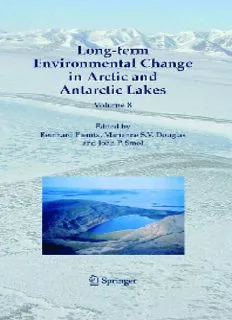
Long-term Environmental Change in Arctic and Antarctic Lakes, Vol. 8 (Developments in Paleoenvironmental Research) PDF
Preview Long-term Environmental Change in Arctic and Antarctic Lakes, Vol. 8 (Developments in Paleoenvironmental Research)
Long-term Environmental Change in Arctic and Antarctic Lakes Developments in Paleoenvironmental Research VOLUME 8 Long-term Environmental Change in Arctic and Antarctic Lakes Edited by Reinhard Pienitz Université Laval, Québec, Canada and Marianne S.V. Douglas University of Toronto, Toronto, Canada and John P. Smol Queen's University, Kingston, Canada AC.I.P. Catalogue record for this book is available from the Library of Congress. ISBN-10 1-4020-2125-9 (HB) Springer Dordrecht, Berlin, Heidelberg, New York ISBN-10 1-4020-2126-7 (e-book) Springer Dordrecht, Berlin, Heidelberg, New York ISBN-13 978-1-4020-2125-1 (HB)Springer Dordrecht, Berlin, Heidelberg, New York ISBN-13 978-1-4020-2126-8 (e-book)Springer Dordrecht, Berlin, Heidelberg, New York Published by Springer, P.O. Box 17, 3300 AADordrecht, The Netherlands. Cover Photo: Hanging Lake, Yukon Territory, Canada (photo taken by Julien Racca). Inset: Subarctic Lake near Umiujaq, Northern Québec, Canada (photo taken by Reinhard Pienitz). Printed on acid-free paper All Rights Reserved © 2004 Springer No part of this work may be reproduced, stored in a retrieval system, or transmitted in any form or by any means, electronic, mechanical, photocopying, microfilming, recording or otherwise, without written permission from the Publisher, with the exception of any material supplied specifically for the purpose of being entered and executed on a computer system, for exclusive use by the purchaser of the work. Printed in the Netherlands. DEDICATION This book is dedicated to our friend and colleague Dr. John C. Kingston (1949-2004), whose passion for diatoms and life affected us all. CONTENTS Acknowledgements.................................................................................................xii i The Editors.............................................................................................................. xv List of Contributors .............................................................................................. xvii Editors and Board of Advisors of Developments in Paleoenvironmental Research Book Series...........................................................................................xxvii 1. Paleolimnological research in polar regions: An introduction. Reinhard Pienitz, Marianne S.V. Douglas and John P. Smol.....................................1 Introduction Observational/instrumental evidence for rapid climate change in the circumpolar regions Why do we need paleolimnological data from arctic and antarctic regions? Geographic scope of the book The focus and the structure of this volume Acknowledgements References Part I: Major Indicators and Approaches 2. Geochronology of high latitude lake sediments. Alexander P. Wolfe, Gifford H. Miller, Carrie A. Olsen, Steven L. Forman, Peter T. Doran and Sofia U. Holmgren....................................................................19 Introduction Dating recent high latitude lake sediments using 210Pb and 137Cs Radiocarbon dating Optically stimulated luminescence Future directions in high latitude lake sediment geochronology Summary Acknowledgements References 3. Physical and chemical properties and proxies of high latitude lake sediments. Scott F. Lamoureux and Robert Gilbert...................................................................53 Introduction Polar environmental systems High latitude lake systems Physical and chemical proxy records in high latitude lakes vii viii Framework for interpreting the environmental significance of physical and biogeochemical sedimentary records in high latitude lakes Summary Acknowledgements References 4. Palynology of North American arctic lakes. Konrad Gajewski and Glen M. MacDonald.............................................................89 Introduction Synthesis of methodological aspects Select North American studies Conclusion – Outlook Summary Acknowledgements References 5. Algal indicators of environmental change in arctic and antarctic lakes and ponds. Marianne S.V. Douglas, Paul B. Hamilton, Reinhard Pienitz and John P. Smol...117 Introduction Historical overview of algal research in the Arctic and Antarctic Algal indicators Ecological classifications of algae Paleolimnological reconstructions Other applications Summary Acknowledgements References 6. Aquatic invertebrates and high latitude paleolimnology. Ole Bennike, Klaus P. Brodersen, Erik Jeppesen and Ian R. Walker.....................159 Introduction Notes on different zoological indicators present in lake sediments Discussion Summary Acknowledgements References ix 7. Use of water isotope tracers in high latitude hydrology and paleohydrology. Thomas W.D. Edwards, Brent B. Wolfe, John J. Gibson and Dan Hammarlund...187 Introduction Isotopic labelling in the hydrological cycle Isotope hydrology at high latitudes Water isotope tracers in paleolimnology Summary and future perspectives Acknowledgements References 8. Lake sediments as records of arctic and antarctic pollution. Derek C.G. Muir and Neil L. Rose.........................................................................209 Introduction Challenges in the study of high latitude lake sediment cores Spatial and temporal trends of metals, persistent organic pollutants and anthropogenic particles Summary Acknowledgements References Part II: Regional Syntheses 9. Paleolimnology of the middle and high Canadian Arctic. Alexander P. Wolfe and I. Rod Smith.....................................................................241 Introduction Environmental background Wisconsinan glacial history The limnological legacy Historical development Pre-Holocene lake sediment records Holocene climatic evolution and paleolimnology The latest Holocene: a time of unprecedented change Problems, recommendations and conclusions Summary Acknowledgements References x 10. Paleolimnology of the North American Subarctic. Bruce P. Finney, Kathleen Rühland, John P. Smol and Marie-Andrée Fallu........269 Introduction Description of study region Paleoindicators of the North American Subarctic Regional syntheses Challenges and future directions Summary Acknowledgements References 11. Holocene paleolimnology of Greenland and the North Atlantic islands (north of 60°N). N. John Anderson, David B. Ryves, Marianne Grauert and Suzanne McGowan...319 Introduction Paleolimnological themes across the northern North Atlantic Synthesis and areas for further research Summary Acknowledgements References 12. Paleolimnological research from northern Russian Eurasia. Glen M. MacDonald, Thomas W.D. Edwards, Bruce Gervais, Tamsin E. Laing, Michael F.J. Pisaric, David F. Porinchu, Jeffrey A. Snyder, Nadia Solovieva, Pavel Tarasov and Brent B. Wolfe.........................................................................349 Introduction Recent analyses using biological evidence Stable isotope studies of lake sediments from across northern Russian Eurasia Regional lake status data bases and lake-level records from northern Russian Eurasia Summary Acknowledgements References 13. Paleolimnological studies in arctic Fennoscandia and the Kola Peninsula (Russia). Atte Korhola and Jan Weckström...........................................................................381 Introduction Origin and sedimentological characteristics of lakes Holocene changes in physical attributes Holocene trends in chemical attributes
Description: